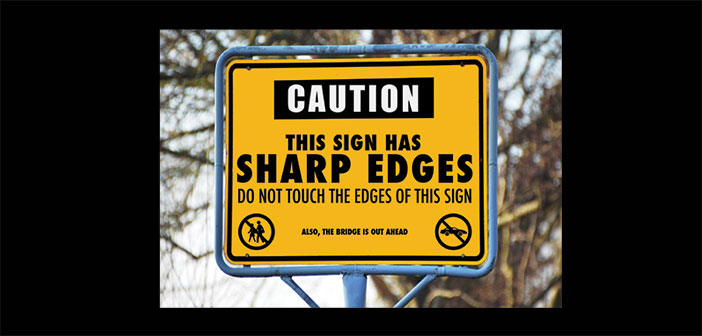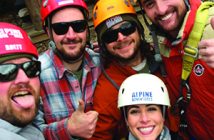How well do you communicate with your guests? Sure, you describe your park, provide FAQs, advise on clothing and sunscreen, warn about potential risks, and send everyone through ground school. You post signs and videos to show folks what to expect and how to gear up, and your employees are trained to deliver instructions and warnings and answer questions. But how much of it actually sinks in?
The ultimate goal or end result of your communications is to influence behavior. That means, first, convincing guests to visit your park, and then once on-site, adequately and appropriately preparing them for the experiences they will enjoy. Doing that effectively requires an integrated system of communications that starts before they arrive and ends after they leave.
To be effective, your communications must be both relevant and specific. And you must deliver the message in a way that the target audience can understand—the delivery of instructions and warnings for a 12-year-old should be vastly different than for her 66-year-old grandfather.
There are, in fact, six critical components for you to consider in creating a system of effective guest communications.
- What to communicate: the content.
- What the communication looks like: the font, colors, iconography, images, etc.
- How to communicate: the methods of delivery.
- How many times to communicate: the number of impressions to deliver.
- When to communicate: different types of information appear at different points in the communications cycle.
- Where to communicate: to be most effective.
I. What to Communicate: The Content
Beyond the basic park information—location, parking, contact info—you should consider providing information that will help prepare guests regarding what to bring (water, sunscreen, rain gear, gloves), what to wear (comfortable clothes, closed-toe shoes, sunglasses, eyeglass retainers), and what to expect (the extent and duration of physical activity). Guests will appreciate this practical advice.
It’s also important to talk to guests about the risks associated with their participation, and how to help minimize it. Liability releases/waivers can set out the range of risks involved with the activity(s) and on the park grounds generally. A list of rules and regulations further prepares guests. Those rules include any age/weight/height restrictions and clothing or footwear requirements. Ground school will help demonstrate and describe how to use the equipment, participate in the activity, and will allow your guests to interact with the guides, who provide them with instructions on expected practices, such as one person on an element at a time, belay procedures, park etiquette, etc.
Other communications provide directions for guests on-site, and may include the location of various services: F&B, gift shop, photo service, restrooms, gear-up area, etc.
II. What It Looks Like: Appearance is Everything
For all printed matter and signage, there are several key considerations. Some of these carry their own messages. For example:
FONT: The type of font, size, and whether it is bold, italicized, and/or underlined.
COLORS: For safety-related signs, use colors that speak to warnings, danger, and hazards. There may be an ANSI standard about these things for some activities.
ICONOGRAPHY: Use recognizable images, pictures, and symbols. If you have a trail or attraction rating system, make sure it is explained clearly.
These guidelines also apply to your website and social media. Wherever the messages appear, they should be consistent in every way possible. That helps make your communications not only “integrated” but also more understandable to first-time visitors. Remember, your guests are outside of their normal element. Anything you can do to relate this new and exciting experience to something they may have experienced in the past (through general life experience) will help them not only comprehend what is going on, but also understand what is required of them to participate safely and create a more enjoyable experience.
III. How to Communicate: Delivery Methods
WEBSITE: The time to begin communicating is when consumers are still in the process of making the decision to engage in the activity and visit your park, as well as once they have made the decision. This communication is typically broad-based: in words, pictures, maps, graphics, and video, for example.
The website is also your first opportunity to communicate instructions, rules and warnings. Provide a waiver that includes warnings, acknowledgments of risks and hazards, and an agreement not to sue (you should insist all participants sign one, regardless of enforceability in your state). Consult with local legal counsel for specific advice in this area. Explain the importance of parents or legal guardians signing for their children. Note: In some states, this does not include a chaperone on the day of a park visit—it must be a legal guardian, who should sign one either online or print one from your website ahead of time and send it with the minor.
FAQs are another good technique to provide valuable information to your prospective guests, and to repeat some of the more important messages on your website.
EMAIL: This is a great vehicle to answer specific questions, provide practical information, educate about risk, and upsell your additional services—photo service, food and beverage, etc.
Print: This includes brochures, signs, posters, trail and park maps, table tents, and other collateral material. Use consistent verbiage, fonts and colors across all these materials. Again, that’s what keeps your communications integrated.
VIDEO: Video is effective when used on your website, in social media, and also on-site at points of sale and in gear-up areas. Consider how best to use for kids, and how to present info for those who don’t speak or read English. Video is an alternative delivery format for many types of information and instruction—some people are visual learners. Again, keep the language and the look consistent.
SIGNS: Signs containing instructional and warning language should be posted in various locations around your park. This can be done without detracting from the overall “feel” you want to provide to your guests. Signs and posters are especially useful at points of sale, and in the gear-up area, retail shop, and F&B outlets, as well as at key points on an aerial park. However, signs are a passive form of communication, and, especially for visual learners, may be somewhat limited in effectiveness. This reinforces the need for an integrated approach to guest communications that utilizes a variety of delivery methods. And again, keep the language and the look consistent.
SCRIPTING: In concert with passive forms of communication, active/interactive communication by and between your guests and employees is highly effective—especially when the information provided is consistent. Scripting helps ensure that’s the case. Many parks do a great job scripting for ground school and for the delivery of instructions for a zip tour or adventure park course. But scripting can also be effective in delivering consistent, accurate messaging for those who answer the phone—our Park Spy shows how important that can be. Scripting can also assist those who don’t (just) answer the phone all day, and who may not have the strongest communication and guest service skills. Providing employees with content and training helps keep the message consistent.
IV. How Frequently to Communicate: Quantity of Impressions to Deliver
Say it…say it again…and again…and again. On your website, in print, in video, and on signs. And then…say it again.
For much of what you want to communicate, repetition is key. Let me say that again…repetition is key! Repetition is the key to remembering, and that is essential for (ultimately) influencing your guests’ behavior. Did I mention that repetition is key?
Here’s what the communications cycle looks like:
Park user sees message
(online, in parking lot, at POS).Park user reads message.
Park user comprehends message.
Park user remembers message.
Park user applies message (content) to specific future circumstances.
In other words, the delivered communications influenced the park user’s decision-making and conduct—it modified her behavior.
For most people, it often takes several exposures to information to activate this cycle. That’s why ground school typically includes a verbal description, guide demonstration, guest demonstration, and guest practice. This communications chain gives each guest at least four impressions from which to learn, and four ways to take it in.
V. When to Communicate: Different Info at Different Points
OK, so how do you activate this chain of communication events?
- Start before they arrive, via website and welcome emails.
- Once they arrive, show and tell them where to park, how to find the sales desk, gear-up area, ground school, and the courses. Give them information about the courses, describe any trail or activity rating systems, and provide warnings about appropriate footwear, loose clothing and hair, and other safety-related issues.
- Remind them that notwithstanding everything that you, as a park operator, can and will do, they are ultimately responsible for their own safety through appropriate decision-making and conduct.
- While they are in the park, remind them of safety and courtesy protocols via signs and in person, and offer “local color” that enriches the experience.
- After they participate, remind them of your park’s amenities and guest services (food, drink, photos, gifts, etc.) and thank them for coming. You might even invite them to return. Do that on site via signs and personal touch, and also in post-visit emails.
VI. Where to Communicate: The Most Effective Places
Before they arrive
- On your website’s dedicated activities page with each attraction described. Not just products and pricing, but also information and warnings.
- Pre-arrival email
- Social media
When they arrive
- At the point of sale
- At the rental/retail shop
- At attraction access points, and on zip line/aerial park platforms.
When they are riding/sliding/zipping/etc.
- At trailheads, at points along the trail (as necessary), such as on platforms.
- Engagement with guides and other employees.
After they ride/slide/zip/etc.
- F&B outlets
- Thank-you emails
KEEP IT ALL INTEGRATED
• Consider all the parts and pieces. Keep the message consistent across different methods of delivery.
• Use multiple methods of delivery. People learn in different ways. Plus, by providing multiple opportunities to consume the message, your guests will not only get the message, but also will be more likely to comprehend it, remember it, and ultimately apply it.
• Use ALL delivery methods that apply to your operation.
• Be repetitive. Be repetitive.
• Be comprehensible. Not just simple, but easy to understand.
• Be comprehensive. Tell the whole story.
• Be specific. Otherwise, you leave your message open to interpretation, and that can lead to unintended and often unimagined consequences.
• Be relevant. Address the topic at hand and don’t distract them with irrelevant thoughts.
• Take nothing for granted. Spell it all out. Remember, for many guests, the entire experience, and everything about your location, is foreign territory.
• Get ‘em BEFORE they get to you.
• Evaluate your program with a critical eye. Are your communications effective? Consider auditing your guests or engaging a secret shopper to see how well you’re doing.At the end of the day, the ultimate goal of your guest communications program is to build an integrated system that will effectively provide your guests with information, instructions and warnings so they may have a reasonably safe and enjoyable experience at your park.




